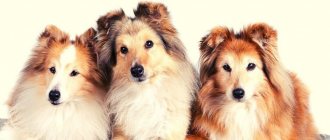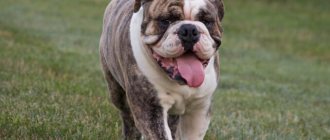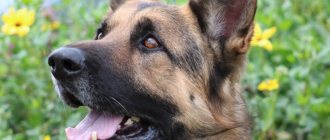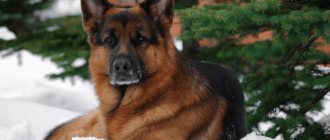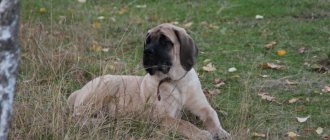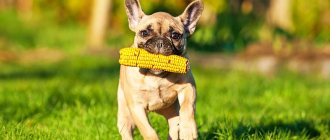The Sheltie is one of the smallest cattle dogs bred in the UK. It appears to be a miniature version of a long-haired collie. But these are two separate breeds, although the difference between them is not immediately noticeable. The Sheltie's popularity is explained by its compact size, high intelligence, beautiful appearance and amazing character. But you shouldn’t get such a pet without first studying its description, pros and cons, and reviews.
- Head
- Features of education and training
- Sheltie coat care
Breed characteristics
| Short description | |
| Origin: | Great Britain |
| Conditions of detention: | Apartment or house |
| Purpose: | Shepherd; companion |
| Color: | Tricolor and bicolor |
| Wool length: | About 12 cm |
| Adult dog size: | Weight from 5 to 12 kg, height from 35 to 40 cm |
| Average life expectancy: | 14 – 16 years old |
| Walk: | Walking twice a day is required |
| Physical activity needs: | Activity level is high, but can get by with 2 – 3 hours a day |
| Fédération Cynologique Internationale (FIC) classification: | Group 1 – herding and cattle dogs except Swiss cattle dogs; section 1 – shepherd dogs |
| Puppy price: | From 15,000 rubles to 35,000 rubles |
Price
Today, there are nurseries for cute shepherd dogs in almost every capital of the CIS - Kyiv, Moscow, Minsk, etc. In Russia they are very loved and pampered.
Also, anyone can purchase a pedigree for an animal. The Sheltie price for 2022 ranges from 20 to 35 thousand rubles. Low-breed dogs from private breeders are sold cheaper, about 15 thousand rubles.
History of the origin of the species
The true history of the origin of the Sheltie is not known; historians and zoologists have several different opinions. One thing is certain: the breed was bred on the Shetland Islands.
160 kilometers from the coast of Scotland, at the intersection of the North Sea and the Atlantic Ocean, there are 10 small Shetland islands. It was there that the Shetland Sheepdog breed originated.
Many people confuse Sheltie with Collie; they do have a striking resemblance in appearance, but are two completely different breeds. Moreover, the collie did not become the basis of the genetic code for the Sheltie.
The harsh climate of the Shetland Islands did not allow the local population to engage in anything other than cattle breeding. The residents needed a dog that could handle a small flock of sheep. It is unprofitable to keep a large shepherd dog for such purposes. That's how the Sheltie appeared.
If you carefully examine the dog, it clearly shows Spitz-like features - a shortened muzzle, small ears and a protruding chest. Northern Spitz-types became the progenitors of the breed. During the selection process, the Shetland Sheepdogs were supplemented with the blood of Greenland Cattle Dogs, Spaniels and Schipperkes. Lastly, in the 19th century, the genetics of long-haired collies were added, and then the breed acquired its final form.
The breeders have created an excellent, vigilant shepherd's assistant. Which, despite its compact size, managed the herd perfectly. In addition, he had such a beautiful and aristocratic appearance that they began to export him to the continent as an expensive gift.
The first breed standard was registered in 1948, by which time the breed had finally formed and acquired a form that has remained almost unchanged to this day.
The first specimens were brought to Russia in 1994 , but despite all their positive qualities, they never gained widespread popularity. But those who at least once got themselves a Sheltie no longer betray this breed.
Application
For a long time and until the end of the 19th century, Sheltie belonged to the breed of dogs that were used as guards of shepherd herds.
This skill can still be taught to a pet, but it should be remembered that a miniature dog can only monitor a small population.
Most often in the modern world, Sheltie dogs are pets.
Friendly Sheltie family
Distinctive features
The main distinctive features of the Sheltie:
- General form. A small, well-proportioned dog with thick, long hair. The movements are light and relaxed.
- Height. Height at the withers for males is 36 – 39 cm, for females 35 – 37 cm
- Head. Small, wedge-shaped, tapering towards the nose. The occipital protuberance is not pronounced, the cheekbones are flat, the transition from the forehead to the muzzle is moderately pronounced. The eyes are slightly slanted, symmetrically located, almond-shaped, brown or blue in color. The ears are small, semi-erect.
- Muzzle. Narrow, nose black, lips close-fitting, black, head and muzzle equal in length. Scissor bite, teeth tightly clenched.
- Neck. Dry, without dewlap, with pronounced muscles, slightly curved, which gives the dog an aristocratic appearance.
- Frame. Compact, lightweight, free from dampness. The stomach is tucked in, the back is straight, the lower back is moderately rounded. The ribs protrude slightly, the chest is narrow, dropped below the elbows.
- Limbs. Straight, light, rounded pasterns, fingers closed. The thighs are strong, muscular, but tight, without dampness. Shoulders and shoulder blades of equal length. The shoulders are set obliquely, tilted back.
- Tail. Long, low set, profusely pubescent, never rising above the level of the back. The tail length is ideally slightly below the hock joint.
- Coat and color. Two-layer, very thick. The undercoat is light but abundant. The guard coat is long and moderately hard. Longer on the tail and chest than along the body. Bicolor color options - black and white, red and white; tricolor - black and white with red tan, sable, blue merle, bi-merle.
- Sexual dimorphism. Pronounced, females are much more compact and “feminine” than males.
Colors
The standard assumes the possibility of several colors:
- Sable. Red and its different shades, located differently on the body.
- Tricolor. Rich black on the body, red tan on the neck, always white spots on the chest, paws and belly.
- Marble blue. Pure silver-gray background with marbled black streaks. Red tan marks on the neck are considered a great advantage, but their absence is not a reason for deducting points.
- Black and white. Similar to tri-color, but without the tan.
It is desirable to have white spots on the chest, frill, paws, tip of the tail, and forehead. Their absence is not a disadvantage, however.
Photo of an adult dog
Breed qualities
Shelties are small in stature, but this did not prevent them from being used as a working dog. A good-natured character did not become an obstacle to the development of security skills.
Sheltie puppies are suspicious of strangers. They can bark loudly and show their teeth, trying to drive away the stranger. At the same time, the pet will not fight with other dogs.
For your information! The Sheltie is a breed that has long been used to herd sheep. The dog's tasks included guarding the flock, searching for stray animals and guarding against thieves.
Despite its height, the Sheltie is an excellent guardian of the apartment.
A dog will be a great alarm. It is important to take into account that such a pet can hardly tolerate loneliness, and long separations will negatively affect its psyche. But with proper training, the Sheltie will become a reliable protector and guard.
Photos of puppies
Features of character and behavior
The Sheltie is a versatile dog. Suitable for all types of owners, both for single people and for large families with small children. Can live in a small apartment and in a large house. The only thing they cannot do without is the attention of the owner.
Shetland Sheepdogs are considered one of the most intelligent dogs. They are among the top 10 easiest to train breeds, occupying an honorable 6th place in this ranking.
Affectionate, good-natured, intelligent pets, incredibly attached to their family, can become excellent nannies for small children. They treat outsiders coldly, with some mistrust, but without unnecessary aggression.
Recipients of 5 stars for communication skills. They can get along with any other animals. Those with whom they live under the same roof are loved selflessly, be it a cat, goose, dog or lizard. The rest are treated indifferently.
They are distinguished by exceptional working qualities, even though they have not worked as shepherds for a long time. The instinct is so strong that you don’t have to worry about a Sheltie while walking; she won’t run away and will carefully graze her owner. They graze the members of their flock family, including all the living creatures living in the house.
The Shetland Sheepdog will not make a good guard dog, but will gladly let its owner know that a stranger is approaching its territory. It is believed that this breed is very noisy, barks a lot and loudly. But unique training abilities can correct this if the owner shows his dissatisfaction with the behavior - the dog will not bark in vain.
Advantages
The main positive qualities of the breed include:
- Mind;
- Obedience;
- Not prone to running away;
- Excellent working qualities;
- Desire to please the owner;
- Attachment to the owner;
- High level of communication skills;
- Excellent training abilities;
- Wary of strangers;
- Suitable for beginner dog owners;
- Unpretentious to living conditions.
The list of Sheltie's advantages can be continued endlessly; there are few breeds in the world that are so universal.
Flaws
The main negative features of this breed include:
- Excessive attachment to the owner can lead to depression;
- They require a lot of attention;
- Not suitable for security;
- Wool needs special care.
You won't find any more faults in a Sheltie.
Interesting Facts
The birthplace of the breed is Scotland. It received its name in honor of the Scottish islands. The dogs were distinguished by their courage and devotion.
Thick wool was dictated by harsh climatic conditions. Short-haired breeds simply would not survive in such an atmosphere.
Thick and long hair is the hallmark of the Sheltie.
For your information! The Sheltie is a breed of dog with unusual skills. The pet can wash itself with its paw like a cat or lie with its paws crossed.
The difference between the dog and other breeds is its talkativeness. He can grumble, moan, howl, purr. With the help of such sounds, the dog communicates with the owner and shows what he wants.
Despite its height, the Sheltie is a good guard. He will chase cats, squirrels and pay attention to strangers. Therefore, the walk requires caution.
Care and maintenance
One of the most unpretentious dogs to keep. It can live in any living conditions, on any territory, in any climate, the main thing is to be closer to people.
Needs active games, moderate physical activity, loves to frolic in the snow, and is not afraid of frost. But if the owner is not in the mood, he will happily just wander around, without pestering him with calls to play.
Caring for your eyes and ears doesn't require much effort. It is enough to stock up on hygiene lotions for these organs. And about once a week or a week and a half, wipe your eyes and ears with a swab dipped in a solution intended for the eyes or ears, respectively.
The claws also do not need to be looked after in any special way. Trim nails as needed. If your dog often walks on asphalt roads or paving slabs, you may be able to forget about trimming his nails completely. Residents of rural areas will have to trim their claws approximately once a month using special forceps (claw clippers).
Nutrition
Breeders of Shetland Sheepdogs strongly recommend feeding them with ready-made, balanced food. The Sheltie has sensitive digestion, like many breeding Sheepdogs. It is difficult to create a complete diet that will not lead to stomach problems on your own. Therefore, you should not save money; it is better to turn to professionals who have developed food for miniature breeds.
The Shetland Sheepdog is not on the list of gluttons; on average, an adult eats about 3 kilograms of dry food per month. This is not much, and even high-end food from a well-known brand will not hit the owner’s wallet.
We recommend that you read a detailed article on the topic: “How and what to feed a dog: types and characteristics of nutrition.”
Health
Sheltie dogs can be safely classified as healthy dogs. Moreover, they are long-lived in the dog world. Some individuals live up to 20 years . And the average life expectancy is considered to be 14 – 16 years .
With the right approach to maintenance and nutrition, no particularly terrible diseases have been identified in Shetland Sheepdogs. The main thing is a well-chosen diet, moderate physical and mental stress.
Vaccinations
- At the age of 6–8 weeks, the breeder administers worm prevention to the entire litter, including the female. After 10–14 days, the procedure is repeated.
- Then, after another 10 days , the first vaccination against hepatitis, enteritis, and plague (Carré disease) is given. Additionally, your veterinarian may prescribe another vaccine against a disease specific to a particular region.
- After 28 - 30 days , a double vaccination is given to enhance the result. If the puppy is healthy and active, they immediately give an injection for rabies. Otherwise, the doctor may postpone the rabies vaccination until the teeth are completely replaced. After the second vaccination, it is recommended to observe another 2 weeks of quarantine.
- The last puppy vaccination is given at the age of 8 - 12 months . Then, every year, they give one injection against rabies and against viral infections.
During the days of vaccinations and taking deworming medication, the dog may experience lethargy, drowsiness, lack of interest in active games, a one-time refusal to feed, and even a single vomiting.
Important article on the topic: “Everything you need to know about dog vaccinations.”
Allergic reactions to modern drugs practically do not happen.
Diseases
Sheltie is not a commercial breed; for the most part, breeders really care about the dogs and are trying to make the livestock healthier. But a large number of mixtures of different genetic codes and an inept approach to inbreeding in the 18th century still gave rise to several diseases, the tendency for which can be seen in modern Shelties.
Common diseases:
- Arthritis (in larger individuals);
- Excess weight (due to improper diet or low physical activity);
- Cataract;
- Retinal degeneration;
- Glaucoma.
I would like to note the frequent rejection of the size standard . Shetland Sheepdogs often outgrow the height limit at the withers.
Walk
Shelties love active recreation . They love to run, jump, and frolic. It has been noticed that even with the onset of old age, they remain playful puppies. But the desire to please the owner forces dogs of this breed to adopt the habits of the owner.
Once in a family where a calm, phlegmatic atmosphere reigns, the Sheltie becomes just as calm and peaceful.
But you shouldn’t abuse your pet’s flexibility. For the normal formation of joints and skeleton, they need physical activity.
Grooming
Grooming requires special attention. Shelties need to be brushed at least twice a week. During the molting period, to avoid the formation of tangles - every day.
To prevent your entire house from becoming covered in hair, you need to acquire a whole arsenal of grooming supplies. Modern pet stores offer them in a wide range.
Necessary equipment for grooming:
- Furminator;
- Massage brush with fine teeth;
- Colt cutter;
- Puhoderka;
- Long-toothed comb;
- A brush with sparse and short teeth.
Under no circumstances should you cut your Sheltie's hair! Their fur no longer grows to the desired length. The dog remains a breed defect.
Washing a long-haired pet is a real challenge. In winter, Shelties do not need to be washed at all, this is fraught with colds. After washing, do not use a hair dryer. Its use causes the guard coat to become overdried and brittle.
The ideal option for drying a dog is a special groomer compressor. It blows out tiny droplets of water from the undercoat and does not harm the guard coat.
We must remember that after bathing, the thick mane of a Shetland Sheepdog completely dries out within 3 days. This cannot be ignored during winter hygiene procedures.
Health
Characteristic diseases
Congenital anomalies, allergies and cataracts are practically not found in this breed, but these dogs are susceptible to several serious diseases:
— bladder cancer is the main cause of early deaths in this breed, diagnosed by regular testing;
- dermatomyositis - a disease of Sheltie puppies, manifests itself in damage to the skin, without proper treatment leads to significant disorders of the nervous system;
- von Willebrand genetic pathology - cannot be treated, dogs with this disease are euthanized in the first months of life;
— violation of the hip joints is a congenital defect that requires surgical correction.
The Sheltie dog breed is suitable for living in a home, but the overflowing energy of a pet can harm the apartment if it is not given the opportunity to run and frolic, like Greyhound dogs. To do this, you should regularly walk the animals.
Mating
Dogs over 18 months old are allowed to breed. In females, as a rule, this is the third sexual heat. The first estrus occurs at the age of 6 to 9 months , depending on the characteristics of the body.
Shelties are bred on the 10th – 12th day of estrus – these are approximate data. Ovulation can occur on the 15th – 18th day of sexual heat, because these are living organisms, it is impossible to accurately predict. A dog does not need to select a time for mating.
Shetland Sheepdogs have a very wide range in the number of puppies per litter. One female can bear 3 - 4 puppies , the other safely gives birth to 6 - 7 .
Before mating, it is recommended that the dog and bitch undergo deworming in order to prevent infection of the offspring.
Read a detailed article on the topic: “Everything you need to know about breeding dogs: appropriate age, what to do if it doesn’t work out, rules and tips.”
Color types
Saint Bernard (dog): characteristics of the breed
The breed standard includes not only exterior data. It is necessary to take into account what color the wool is, and not all options are considered acceptable.
Sable color is the most popular
Acceptable options include black with a small amount of white markings, black with brown and tricolor - a combination of red, brown and black. Separately, they distinguish marble - silver color with a small addition of black specks.
Note! Shelties come in different colors. Thanks to this, the owner can choose a dog to suit his taste. Such a pet will have a spectacular appearance and presentability. For example, the marbled sheltie is immediately visible among other animals.
Any deviations from the standard are considered unacceptable, especially a completely gray color.
Key points in training
Raising a Sheltie is not difficult; even a beginner can handle it. Thanks to their great desire to please their owner, little collie clones will show remarkable obedience. Even children can train Shetland Sheepdogs.
Professional trainers can hope to win prizes in training competitions. Shelties can successfully run agility courses, win in dog frisbee, freestyle, and obedience. Only competitions that include tests of guarding qualities are not suitable for small shepherds.
Read about how to properly train a dog in the article: “Training a puppy: effective methods from dog handlers, learning commands at home.”
Only humane training methods are suitable for Shelties..
When corrective equipment or harsh punishment methods are used, the dog can become intimidated and angry. Contact with the trainer will be lost and will have to be restored for a long time.
Nutrition
A Sheltie puppy be fed differently than an adult representative of the breed. Until it is fully formed, you need to help its body enrich itself with useful substances: calcium, vitamins A, B and C, zinc, iron, bacteria for digesting food, etc.
A commercial diet is indicated only for adult Shetland Sheepdogs whose bodies are already fully developed. Kids should be given: cottage cheese, boiled eggs, meat products, milk, fresh fruits, boiled potatoes, fresh vegetables and berries. It is worth limiting its consumption: pasta, fatty meat broths, chocolate, smoked meats and baked goods.
Important! Giving such a dog sharp bones, as well as meat that may contain them, is strictly prohibited.
You can also treat your puppy to low-fat boiled fish, beef, broccoli, mushrooms or soups. Among flour products, he is allowed the following semi-finished products: homemade dumplings and dumplings, pancakes, pizza. But don't let your pet eat too much flour products, because they increase gas formation in the stomach.
How to choose a puppy
Since the Sheltie is not a commercial breed, the danger of buying a sick puppy is minimized. But you still shouldn’t go to the poultry market to buy a purebred dog; good breeders don’t sell their puppies there.
First you need to determine the purpose for which you are purchasing a pet. If this is a favorite of family and children or a reliable companion for a lonely person, then you can search for the nearest breeder on the Internet.
If you need a dog with show potential or a farm assistant. It’s definitely worth going to a major exhibition and looking for a breeder there.
Nursery owners are worried about their “children” for this reason, they are willing to make contact, and answer all questions with pleasure. They are happy to help you choose food, supervise at exhibitions, and help solve any difficulties that arise.
Sheltie will warm your heart in bad weather. Ready to be there in any situation: to cheer you up when you’re sad; calm down when anxious; protect when you're scared. The owner of a Shetland Sheepdog is not in danger of loneliness - she will always be there.
5 / 5 ( 3 voices)
Price
The Sheltie is not a commercial breed; it is bred by exceptional connoisseurs of good genetics and standards. This is a big plus, both for the quality of the offspring and the cost of the puppies.
In Russia, you can buy an excellent puppy with a pedigree and “elite” show parents for 30,000 – 35,000 rubles. More mediocre blood, not for breeding and exhibitions, will cost 15,000 - 20,000 rubles.
In central European countries, a Sheltie costs about 400 euros.
